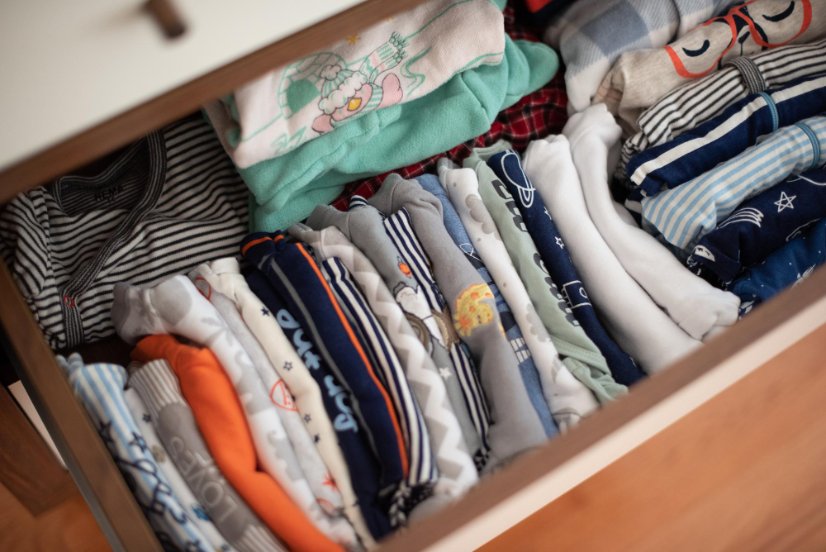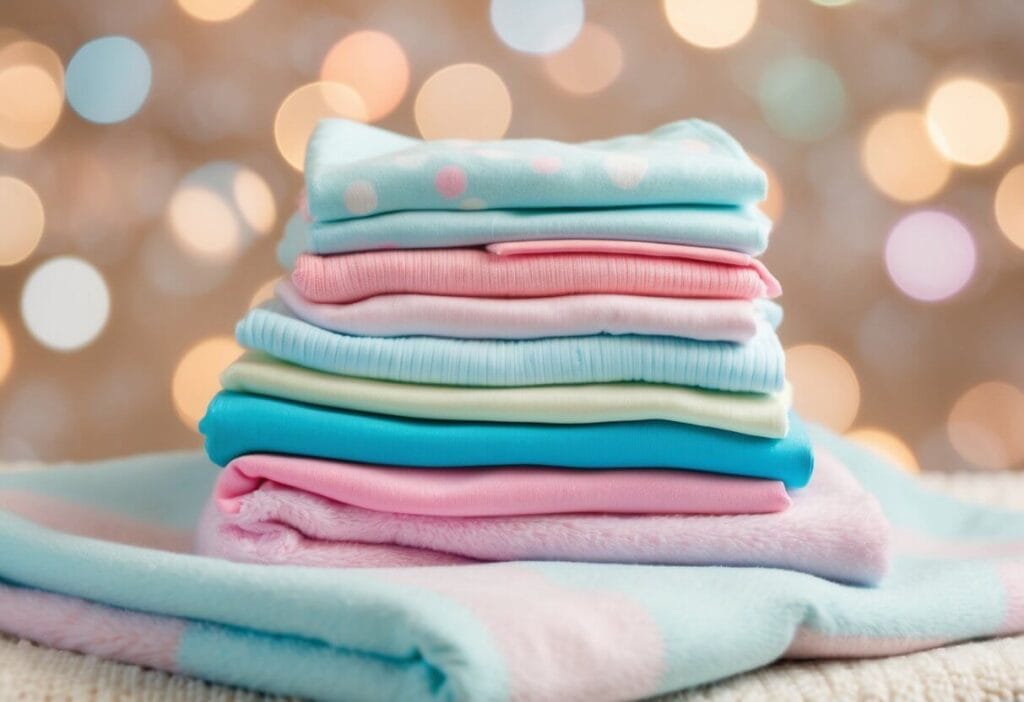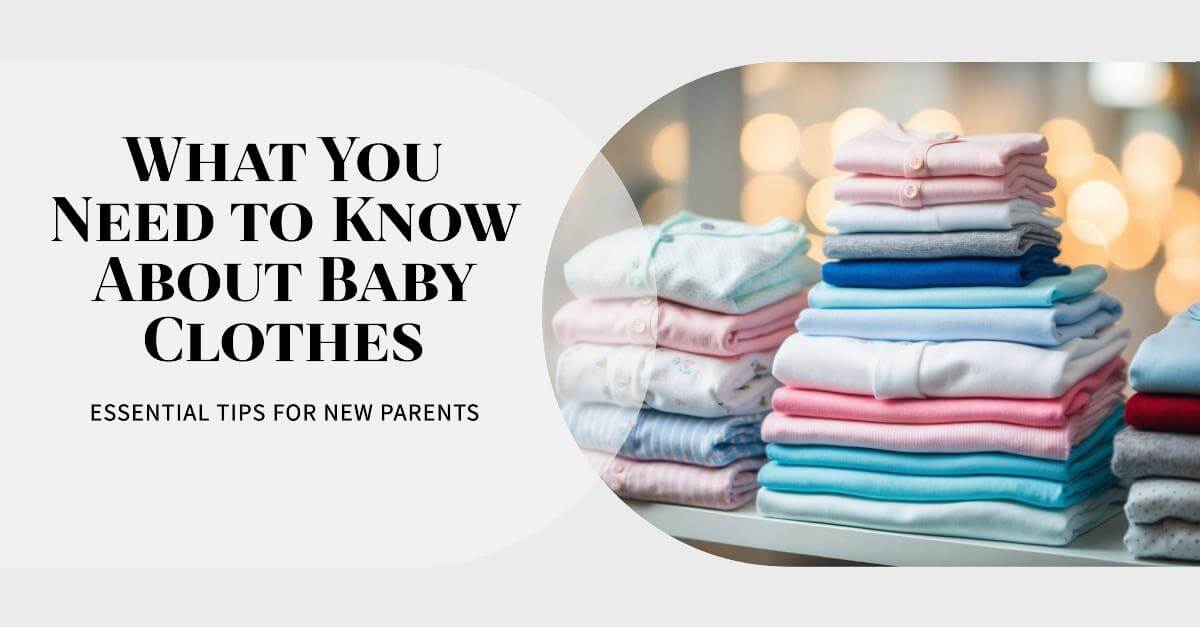Getting ready for a new baby can be exciting and a bit overwhelming. Picking out clothes for your little one is a fun part of the process, but it’s important to know what you really need. Newborns grow quickly, so it’s best to focus on buying a few newborn items and more clothes in larger sizes.
When shopping for baby clothes, think about comfort and practicality. Soft, stretchy fabrics are ideal for sensitive newborn skin. Look for items that are easy to put on and take off, like bodysuits with envelope necks and sleep suits with zips. It’s also wise to consider the season when your baby will arrive and choose appropriate clothing.
Remember that babies don’t need a lot of fancy outfits. Stick to basics like bodysuits, sleep suits, and simple trousers or leggings. Don’t forget essential accessories like hats, socks, and mittens to keep your little one cosy. With these basics, you’ll be well-prepared for your new arrival.
On This Page
Key Takeaways
- Choose a mix of newborn and larger sizes to account for rapid growth
- Opt for soft, comfortable fabrics and easy-to-use fastenings
- Focus on practical basics rather than fancy outfits
Understanding Baby Clothing Sizes

Baby clothing sizes can be tricky to navigate. They often vary between brands and may not match your baby’s age. Weight and height are more reliable indicators for choosing the right fit.
Newborn Clothing Essentials
Newborn clothes fit babies up to 5-8 pounds. Most infants outgrow this size quickly. It’s best to buy a few basics:
- 4-6 bodysuits or vests
- 4-6 sleepsuits or babygrows
- 2-3 cardigans or jackets
- 4-6 pairs of socks
- 2-3 hats
Choose soft, stretchy fabrics for comfort. Look for easy fasteners like zips or poppers. Avoid clothes with small buttons or decorations that could come loose.
Baby Clothes Checklist for 0-3 Months
The 0-3 month size typically fits babies weighing 8-12 pounds. You’ll need more items as your baby grows:
- 6-8 bodysuits or vests
- 6-8 sleepsuits
- 4-6 tops
- 4-6 leggings or trousers
- 2-3 cardigans or jackets
- 4-6 pairs of socks
- 2-3 hats
- 2-3 blankets
Consider the season when choosing clothes. Layer thin clothes for warmth instead of thick items. Always check the fit around the neck and arms to ensure comfort.
Selecting the Right Baby Clothes

Picking the best clothes for your little one involves thinking about comfort, safety, and practicality. The right choices can make life easier for both baby and parents.
Choosing Comfortable Fabrics
Soft, breathable fabrics are key for baby clothes. Cotton is a top choice, as it’s gentle on delicate skin and allows air flow. Look for items made from 100% cotton or cotton blends.
Avoid scratchy materials or clothes with rough seams. These can irritate a baby’s skin. Stretchy fabrics like cotton jersey are great for easy dressing and nappy changes.
For sleepwear, opt for snug-fitting clothes made from flame-resistant materials. This helps keep babies safe while they sleep.
Safety Considerations in Baby Clothes
When buying baby clothes, check for any small parts that could come loose. Buttons, snaps, and decorations should be firmly attached.
Avoid clothes with drawstrings, especially around the neck area. These can pose a choking risk. Instead, look for elastic waistbands and necklines.
Make sure zips have a fabric cover at the top to prevent skin pinching. Check that any appliqués or prints are safe and won’t peel off.
Seasonal Clothing Choices
In warm weather, dress babies in light, airy clothes. Onesies and bodysuits are perfect for keeping cool. Don’t forget a sun hat to protect their head and face.
For colder months, layers work best. Start with a vest, add a sleepsuit, then a cardigan or jacket. Footed pyjamas are great for keeping tiny toes warm at night.
Always have a few extra layers on hand, as babies can’t control their body temperature well. A light blanket or shawl is handy for quick warmth.
Remember to dress your baby in one more layer than you’re wearing. This helps them stay at the right temperature in any weather.
Baby Clothing Accessories

Baby clothing accessories enhance comfort and protection for little ones. They provide warmth, shield delicate skin, and help with everyday care.
Essential Accessories for Comfort
Socks and booties keep tiny toes warm. Soft, stretchy socks work well for newborns. Booties with elastic or ties stay on better for active babies.
Scratch mitts protect babies from scratching themselves. They’re useful for infants who can’t control their hand movements yet.
Burp cloths are handy for feeding time. They protect clothes from spit-up and can wipe baby’s mouth. Choose absorbent fabrics like cotton or terry cloth.
Hats are important for regulating body temperature. Soft cotton caps work for indoors. Snug-fitting hats with chin straps are best for outdoor use.
Protective Accessories for Different Weathers
In cold weather, mittens keep little hands warm. Look for ones that are easy to put on and stay in place.
For rainy days, waterproof hats and boots help keep babies dry. Choose lightweight, breathable materials to prevent overheating.
Sun hats with wide brims protect sensitive skin in warm weather. Some have flaps to cover the neck too.
For chilly days, layer with cardigans or light jackets. These are easy to add or remove as needed.
In windy conditions, use blankets or footmuffs for prams. These add an extra layer of warmth without bulky clothing.
Nursery Bedding and Sleep Safety

Choosing the right bedding and following safe sleep practices are crucial for your baby’s health and well-being. Let’s look at key points to keep in mind when setting up your little one’s sleep space.
Choosing the Right Bedding
For newborns, less is more when it comes to bedding. A firm cot mattress covered with a fitted sheet is all you need. Avoid loose blankets, pillows, and duvets as they can be risky for young babies.
Cellular blankets are a good choice if you need extra warmth. They’re light and have small holes that let air flow through. This helps keep your baby at the right temperature.
As your baby grows, you can add a light blanket. Tuck it in firmly below their shoulders to keep it secure.
Remember: • Use fitted sheets that fit snugly on the mattress • Choose breathable materials like cotton • Avoid cot bumpers and soft toys in the sleeping area
Understanding SIDS and Safe Sleep
SIDS (Sudden Infant Death Syndrome) is a worry for many parents. While its exact cause isn’t known, there are steps you can take to lower the risk.
Always put your baby to sleep on their back on a firm mattress. Keep the cot clear of items that could cover their face or make them too hot.
Don’t let your baby overheat. A room temperature of 16-20°C is ideal. Feel your baby’s chest or back to check if they’re too warm.
Other safe sleep tips: • Don’t smoke around your baby • Keep the cot away from heaters and direct sunlight • Use a baby sleeping bag instead of loose covers
By following these guidelines, you can help create a safe sleep environment for your little one.
Baby Sleepwear and Comfort
Choosing the right sleepwear for your baby is key for a good night’s rest. The right clothes help keep your little one cosy and safe while sleeping.
Sleepwear Essentials
Babies need comfortable clothes for bedtime. Soft pyjamas or sleep suits are great choices. Look for items made of breathable fabrics like cotton. These help keep baby’s skin cool and dry.
For warm nights, a vest or just a nappy may be enough. In cooler weather, add layers as needed. Footie pyjamas can keep tiny toes warm without the need for socks.
Avoid clothes with strings or loose parts. These can be unsafe for sleeping babies. Zip-up sleepers are easy to put on and take off for nappy changes.
Swaddling and Sleep Bags
Swaddling can help newborns feel snug and secure. Use a thin blanket or special swaddle wrap. Make sure it’s not too tight around the hips.
As babies grow, sleep bags become a good option. These wearable blankets keep babies warm without loose covers. Choose the right size and thickness for the room temp.
Sleep bags come in different togs. A lower tog is best for warmer weather. Higher togs suit colder nights. Always check that your baby isn’t too hot or cold.
Some babies prefer arms-out sleep bags. Others like ones that keep arms tucked in. Try different styles to see what works best for your little one.
Transportation and Travel with Baby
Travelling with a baby requires careful planning and the right gear. Proper safety equipment and mobility aids are essential for smooth journeys with your little one.
Car Seats and Travel Safety
Car seats are crucial for baby’s safety during car trips. Choose a rear-facing seat for infants up to at least 15 months old. Ensure the seat is securely installed and fits your child’s age and size.
Check that the harness straps are snug and at the correct height. Never place a rear-facing car seat in front of an active airbag. For air travel, use an approved car seat that fits airline seats.
Always read the manual and follow installation instructions carefully. Some seats can attach to prams for easy transfers between car and pushchair.
Strollers and Prams for Mobility
Strollers and prams offer convenient ways to transport babies when out and about. Prams are ideal for newborns, providing a flat, supportive surface. Pushchairs are suitable once baby can sit up.
Look for models with adjustable handles, sturdy wheels, and good suspension. A carrycot attachment is useful for young infants. Consider a travel system that combines a car seat and pushchair for versatility.
Lightweight, foldable strollers are handy for trips. Ensure the brakes work well and the frame is stable. Add a rain cover and sun shade for weather protection.
Baby Care Essentials
Taking care of a newborn requires some key items for their health, comfort and nourishment. The right tools can make daily tasks much easier for new parents.
Health and Grooming
A baby thermometer is crucial for checking your little one’s temperature. Digital ear or forehead thermometers are quick and easy to use. Keep cotton wool or gentle wipes handy for cleaning delicate skin.
Nail scissors with rounded tips help trim tiny fingernails safely. A soft hairbrush and comb can soothe your baby during grooming. Don’t forget barrier cream to prevent nappy rash.
A play mat provides a safe, comfy spot for tummy time and play. Look for one with textures, colours and sounds to engage your baby’s senses.
Feeding and Nursing
For bottle-feeding, you’ll need several feeding bottles and teats. Sterilising equipment is a must to keep bottles germ-free.
If breastfeeding, nursing bras offer comfort and easy access. A breast pump can be handy for expressing milk. Nursing pillows help position baby comfortably during feeds.
Muslin cloths are great for mopping up spills and can double as a light blanket. Bibs protect clothes during messy mealtimes.
A baby monitor lets you keep an ear out while your little one sleeps in another room.
Preparing for Baby’s Arrival
Getting ready for a new baby involves careful planning and gathering essential items. Creating a registry and hosting a baby shower can help ensure you have everything needed for your little one’s arrival.
Setting Up a Baby Registry
A baby registry helps you keep track of needed items and lets friends and family know what to gift. Start by listing essentials like a cot or moses basket, nappies, and clothing. Include different price points to suit various budgets. Add a mix of practical items and a few special wants.
Consider registering for:
- Feeding supplies
- Bathing items
- Car seat
- Pram or pushchair
- Baby monitor
Many shops offer registry services both in-store and online. Some even provide completion discounts on items not purchased from your list.
Planning a Baby Shower
Baby showers are a fun way to celebrate the upcoming arrival and gather supplies. Choose a date about 4-6 weeks before the due date. Pick a theme if desired, but keep it simple. Send invitations 4-6 weeks in advance.
Plan activities like:
- Nappy raffle
- Guess the baby food game
- Decorate a onesie station
Provide light refreshments and consider party favours for guests. Have someone record gifts opened so you can write thank-you notes later. Don’t forget to include the registry information on invitations to help guests with gift selection.
Frequently Asked Questions
How many newborn outfits do I need
Aim for 5-8 bodysuits, 5-8 sleepsuits, and a few cardigans or jackets. Remember, newborns grow quickly!
What size clothes should I buy for my newborn?
Start with a mix of newborn and 0-3 months sizes. Babies vary, so it’s best to have options.
Are organic baby clothes worth the extra cost?
If budget allows, yes. They’re gentler on baby’s skin and more environmentally friendly.
How often should I wash baby clothes?
Wash new clothes before first wear. After that, wash as needed – typically every 1-2 days for frequently used items.
What fabrics are best for baby’s sensitive skin?
Soft, breathable fabrics like cotton, bamboo, and cotton-blends are ideal.
Do I need special detergent for baby clothes?
A mild, fragrance-free detergent is best. Many parents use специальный detergents, but it’s not always necessary.
How can I tell if baby clothes are too small?
If it’s difficult to snap fasteners, clothes ride up, or leave marks on skin, it’s time to size up.
Are secondhand baby clothes safe to use?
Yes, if thoroughly cleaned and in good condition. Avoid used car seats or sleep sacks for safety reasons.
What’s the difference between 0-3 months and 3-6 months sizes?
0-3 months typically fits babies up to 12-13 lbs, while 3-6 months fits babies up to 15-16 lbs. However, this can vary by brand.
How do I dress my baby for sleep safely?
Use a sleepsuit or babygrow without a blanket. The room should be 16-20°C. Avoid hats or hoods indoors.
Are baby shoes necessary for newborns?
No, socks or booties are sufficient until baby starts walking.
How do I choose the right nappies for my baby?
Start with newborn size, then adjust based on your baby’s weight and fit. Consider both disposable and reusable options.
What baby clothes are essential for hospital bag?
Pack 2-3 sleepsuits, 2-3 bodysuits, a coming home outfit, hat, and socks.
How do I remove stubborn stains from baby clothes?
Soak in cold water, apply a gentle stain remover, and wash as usual. Sunlight can help bleach stubborn stains naturally.
Are zippered babygrows better than buttoned ones?
Zippers are quicker for nappy changes, especially at night. However, buttons allow for easier temperature

